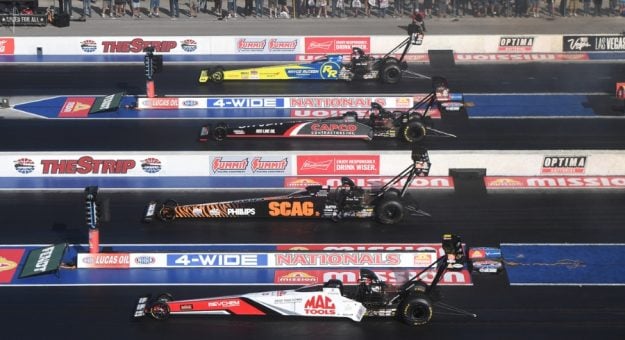CONCORD, N.C. — Four-wide drag racing is a different kind of monster that’s only seen twice on the 21-race NHRA Mission Foods Drag Racing Series schedule.
In both qualifying and eliminations, the format bring two more boxers to the ring, making it an ultra-complicated fight to the finish line for the four racers involved.
“You get used to it after you get beat up a few times,” eight-time Top Fuel champion Tony Schumacher said jokingly. “You’ve gotta man up in that car and you gotta do your job because you know you could have a great race car and have three people take a shot at you and lose.”
Forget about the actual drag race for a second, because the challenge of running a four-wide event begins when a driver rolls up to the staging lane. Not only are there two additional opponents beside them on the drag strip, but for the two drivers occupying the two middle lanes, they’re having to look at a different Christmas tree for their split-second signal to punch the gas.
It may seem trivial, but having a second Christmas tree is quite literally a glaring interruption of routine in a sport where drivers thrive on making their 300-something mph runs feel as normal and mundane as possible.
“It’s not as natural, so you have to be a little more cognizant of the lane that you’re in, not only for your team, but you don’t want to mess anyone else up either,” said Justin Ashley, who consistently posts some of the quickest reaction times in Top Fuel. “It was certainly more difficult for me back in 2021, which was the first four-wide race I ran.”
There are only two Four-Wide Nationals for drag racers to conquer each season — first at The Strip at Las Vegas Motor Speedway and another at zMAX Dragway.
In recent years, NHRA has shifted the schedule to where the two four-wide races are now consecutive events. That change, according to reigning Top Fuel champion Doug Kalitta, has made it a little easier on drivers to adjust to the different racing style.
“Probably (helps) more for the drivers to feel more used to the Christmas tree and whatnot, but it seems like everybody’s doing pretty good these days,” Kalitta said.
Personally, he could do without the awkward Christmas tree positioning, but especially after winning his first four-wide April 14 at Las Vegas, Kalitta doesn’t have many complaints about the format. Even having a three-round elimination format on Sunday, rather than the typical four, is a nice change-up for the Kalitta Motorsports driver.
Not all drivers share Kalitta’s opinion, however, as six-time Pro Stock champion Erica Enders has yet to adjust to the four-wide setup despite it entering its 10th season on the NHRA circuit.
She made that clear on Saturday afternoon when, upon reaching the top end after the Mission #2Fast2Tasty Challenge, she had no idea who won among the quad that just ran — including herself, Jeg Coughlin Jr., Greg Anderson and Christian Cuadra.
“It’s been confusing since day one,” Enders said. “The biggest challenge I think for myself is eye transfer, because you see all these bulbs — like pre-stage and stage — and they’re all flickering. It’s super important to deck the throttle on time, and then transfer your eyes to the three ambers for the drop.
“Then, the biggest challenge is taking that deep breath, relaxing and not getting ahead of yourself — not falling into the trap of everybody else rushing.”
As far as how heightened her senses are on the starting line in a four-wide event, Enders laughed and said, “They’re at the rev limiter.”
